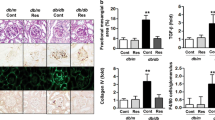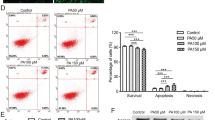Abstract
Adiponectin is an adipocyte derived protein that plays pivotal roles in anti-oxidation, anti-inflammatory and insulin-sensitizing properties by activating two receptors, AdipoR1 and AdipoR2. Recent studies have shown that the down-regulation of AdipoR1 is a known cause of diabetic nephropathy (DN). Resveratrol (Resv), a natural polyphenol, has been identified as a potent activator of forkhead transcription factor O1 (FoxO1) which can up-regulate the expression of AdipoR1. In the present study, we have investigated whether Resv can up-regulate the expression of AdipoR1 by activating FoxO1 that is in kidney of DN rats and mesangial cells (MCs) cultured in high glucose (HG, 30 mmol/L) medium. In vivo, we show that, in the renal cortex of diabetic rats, the expression of AdipoR1 was significantly reduced and correlated with an increase in the generation of malondialdehyde (MDA), Collagen IV and fibronectin proteins. However, administration with Resv significantly increased the expression of AdipoR1. This correlated with not only a decrease in generation of MDA, Collagen IV and fibronectin proteins levels but also more improved kidney pathological and biochemical indicators changes. In vitro, we show that HG-induced depression of FoxO1 activity was associated with the expression of Adipor1 in MCs. Treatment with Resv (20 μmol/L) caused an elevation in the activity of FoxO1 and a significantly increase in the expression of AdipoR1. Furthermore, inhibition of FoxO1 through short hairpin RNA markedly reduced the expression of Adipor1 in MCs cultured by Resv. In conclusion, Resv can significantly increase the expression of AdipoR1 by activating FoxO1 in diabetic kidney. These data also suggest that Resv may serve as a promising agent for preventing or treating DN.




Similar content being viewed by others
References
Forbes JM, Coughlan MT, Cooper ME (2008) Oxidative stress as a major culprit in kidney disease in diabetes. Diabetes 57:1446–1454
Collins AJ, Foley RN, Chavers B, Gilbertson D, Herzog C (2012) United States Renal Data System 2011 Annual data report: atlas of chronic kidney disease & end-stage renal disease in the United States. Am J Kidney Dis 59(A7):e1–e420
Blazquez-Medela AM, Lopez-Novoa JM, Martinez-Salgado C (2010) Mechanisms involved in the genesis of diabetic nephropathy. Curr Diabetes Rev 6:68–87
Singh DK, Winocour P, Farrington K (2011) Oxidative stress in early diabetic nephropathy: fueling the fire. Nat Rev Endocrinol 7:176–184
Fornoni A, Ijaz A, Tejada T, Lenz O (2008) Role of inflammation in diabetic nephropathy. Curr Diabetes Rev 4:10–17
Wu L, Zhang Y, Ma X, Zhang N, Qin G (2012) The effect of resveratrol on FoxO1 expression in kidneys of diabetic nephropathy rats. Mol Biol Rep 39:9085–9093
Eid AA, Gorin Y, Fagg BM, Maalouf R, Barnes JL (2009) Mechanisms of podocyte injury in diabetes role of cytochrome P450 and NADPH oxidases. Diabetes 58:1201–1211
Briggs DB, Giron RM, Malinowski PR, Nuñez M, Tsao TS (2011) Role of redox environment on the oligomerization of higher molecular weight adiponectin. BMC Biochem 12:24
Wu X, Mahadev K, Fuchsel L, Ouedraogo R, Xu SQ et al (2007) Adiponectin suppresses IkappaB kinase activation induced by tumor necrosis factor-alpha or high glucose in endothelial cells: role of cAMP and AMP kinase signaling. Am J Physiol Endocrinol Metab 293:E1836–E1844
Kim YL, Kim TK, Cheong ES, Shin DG, Choi GS (2012) Relation of absolute or relative adiposity to insulin resistance, retinol binding protein-4, leptin, and adiponectin in type 2 diabetes. Diabetes Metab J 36:415–421
Chan KH, Lam KS, Cheng OY, Kwan JS, Ho PW (2012) Adiponectin is protective against oxidative stress induced cytotoxicity in amyloid-beta neurotoxicity. PLoS One 7:e52354
Lee S, Park Y, Dellsperger KC, Zhang C (2011) Exercise training improves endothelial function via adiponectin-dependent and independent pathways in type 2 diabetic mice. Am J Physiol Heart Circ Physiol 301:H306–H314
Yamauchi T, Kamon J, Ito Y, Tsuchida A, Yokomizo T et al (2003) Cloning of adiponectin receptors that mediate antidiabetic metabolic effects. Nature 423:762–769
de Oliveira C, de Mattos AB, Silva CB, Mota JF, Zemdegs JC (2012) Nutritional and hormonal modulation of adiponectin and its receptors adipoR1 and adipoR2. Vitam Horm 90:57–94
Crimmins NA, Martin LJ (2007) Polymorphisms in adiponectin receptor genes ADIPOR1 and ADIPOR2 and insulin resistance. Obes Rev 8:419–423
Dai MH, Xia T, Zhang GD, Chen XD, Gan L et al (2006) Cloning, expression and chromosome localization of porcine adiponectin and adiponectin receptors genes. Domest Anim Endocrinol 30:117–125
Debard C, Laville M, Berbe V, Loizon E, Guillet C (2004) Expression of key genes of fatty acid oxidation, including adiponectin receptors, in skeletal muscle of type 2 diabetic patients. Diabetologia 47:917–925
Cui XB, Wang C, Li L, Fan D, Zhou Y (2012) Insulin decreases myocardial adiponectin receptor 1 expression via PI3 K/Akt and FoxO1 pathway. Cardiovasc Res 93:69–78
Guo Z, Zhao Z (2007) Effect of N-acetylcysteine on plasma adiponectin and renal adiponectin receptors in streptozotocin-induced diabetic rats. Eur J Pharmacol 558:208–213
Tamura Y, Murayama T, Minami M, Matsubara T, Yokode M (2012) Ezetimibe ameliorates early diabetic nephropathy in db/db mice. J Atheroscler Thromb 19:608–618
Lagouge M, Argmann C, Gerhart-Hines Z, Meziane H, Lerin C et al (2006) Resveratrol improves Mitochondrial function and Protects against metabolie disease by activating SIRT1 and PGC-1 alpha. Cell 127:1109–1122
Baur JA, Pearson KJ, Price NL, Jamieson HA, Lerin C et al (2006) Resveratrol improves health and survival of mice on a high-calorie diet. Nature 444:337–342
Chen W, Rezaizadehnajafi L, Wink M (2013) Influence of resveratrol on oxidative stress resistance and life span in Caenorhabditis elegans. J Pharm Pharmacol 65:682–688
Tomé-Carneiro J, Larrosa M, Yáñez-Gascón MJ, Dávalos A, Gil-Zamorano J (2013) One-year supplementation with a grape extract containing resveratrol modulates inflammatory-related microRNAs and cytokines expression in peripheral blood mononuclear cells of type 2 diabetes and hypertensive patients with coronary artery disease. Pharmacol Res 72C:69–82
Mohar DS, Malik S (2012) The Sirtuin system: the Holy Grail of resveratrol? J Clin Exp Cardiolog 3:216
Ajmo JM, Liang X, Rogers CQ, Pennock B, You M (2008) Resveratrol alleviates alcoholic fatty liver in mice. Am J Physiol Gastrointest Liver Physiol 295:833–842
Huang H, Tindall DJ (2007) CDK2 and FOXO1: a fork in the road for cell fate decisions. Cell Cycle 6:902–906
Furukawa-Hibi Y, Kobayashi Y, Chen C, Motoyama N (2005) FOXO transcription factors in cell-cycle regulation and the response to oxidative stress. Antioxid Redox Signal 7:752–760
Puthanveetil P, Wan A, Rodrigues B (2013) FoxO1 is crucial for sustaining cardiomyocyte metabolism and cell survival. Cardiovasc Res 97:393–403
Ponugoti B, Dong G, Graves DT (2013) Role of forkhead transcription factors in diabetes-induced oxidative stress. Exp Diabetes Res 2012:939751
Tsuchida A, Yamauchi T, Ito Y, Hada Y, Maki T et al (2004) Insulin/Foxo1 pathway regulates expression levels of adiponectin receptors and adiponectin Sensitivity. J Biol Chem 279:30817–30822
Sun X, He J, Mao C, Han R, Wang Z, Liu Y et al (2008) Negative regulation of adiponectin receptor 1 promoter by insulin via a repressive nuclear inhibitory protein element. FEBS Lett 582:3401–3407
Cui XB, Wang C, Li L, Fan D, Zhou Y (2012) Insulin decreases myocardial adiponectin receptor 1 expression via PI3 K/Akt and FoxO1 pathway. Cardiovasc Res 3:69–78
Felder TK, Hahne P, Soyal SM, Miller K, Höffinger H (2010) Hepatic adiponectin receptors (ADIPOR) 1 and 2 mRNA and their relation to insulin resistance in obese humans. Int J Obes (Lond) 34:846–851
Roy SK, Chen Q, Fu J, Shankar S, Srivastava RK (2011) Resveratrol inhibits growth of orthotopic pancreatic tumors through activation of FOXO transcription factors. PLoS One 6:e25166
Huang H, Iida KT, Sone H, Ajisaka R (2007) The regulation of adiponectin receptors expression by acute exercise in mice. Exp Clin Endocrinol Diabetes 115:417–422
Chen Q, Ganapathy S, Singh KP, Shankar S, Srivastava RK (2010) Resveratrol induces growth arrest and apoptosis through activation of FOXO transcription factors in prostate cancer cells. PLoS One 5:e15288
Srivastava RK, Unterman TG, Shankar S (2010) FOXO transcription factors and VEGF neutralizing antibody enhance antiangiogenic effects of resveratrol. Mol Cell Biochem 337:201–212
Qiang L, Banks AS, Accili D (2010) Uncoupling of acetylation from phosphorylation regulates FoxO1 function independent of its subcellular localization. J Biol Chem 285:27396–27401
Xia L, Wang H, Goldberg HJ, Munk S, Fantus IG et al (2006) Mesangial cell NADPH oxidase upregulation in high glucose is PKC dependent and required for Collagen IV expression. Am J Physiol Renal Physiol 290:F345–F356
Gorin Y, Block K, Hernandez J, Bhandari B, Wagner B et al (2005) NOX4 NADPH Oxidase mediates hypertrophy and fibronectin expression in the diabetic kidney. J Biol Chem 280:39616–39626
Soler MJ, Riera M, Batlle D (2012) New experimental models of diabetic nephropathy in mice models of type 2 diabetes: efforts to replicate human nephropathy. Exp Diabetes Res 2012:616313
Molitch ME, DeFronzo RA, Franz MJ, Keane WF, Mogensen CE (2004) Nephropathy in diabetes. Diabetes Care 27:S79–S83
Mazzucco G, Bertani T, Fortunato M, Bernardi M, Leutner M (2002) Different patterns of renal damage in type 2 diabetes mellitus: a multicentric study on 393 biopsies. Am J Kidney Dis 39:713–720
Choi R, Kim BH, Naowaboot J, Lee MY, Hyun MR (2011) Effects of ferulic acid on diabetic nephropathy in a rat model of type 2 diabetes. Exp Mol Med 43:676–683
Nakamaki S, Satoh H, Kudoh A, Hayashi Y, Hirai H et al (2011) Adiponectin reduces proteinuria in streptozotocin-induced diabetic Wistar rats. Exp Biol Med 236:614–620
Klahrs (1999) Mechanisms of progression of chronic renal damage. J Nephrol 12:53–62
Barthel A, Schmoll D, Unterman TG (2005) FoxO proteins in insulin action and metabolism. Trends Endocrinol Metab 16:183–189
Van Der Heide LP, Hoekman MF, Smidt MP (2004) The ins and outs of FoxO shuttling: mechanisms of FoxO translocation and transcriptional regulation. Biochem J 380:297–309
Jacobs FM, van der Heide LP, Wijchers PJ, Burbach JP, Hoekman MF (2003) FoxO6, a novel member of the FoxO class of transcription factors with distinct shuttling dynamics. J Biol Chem 278:35959–35967
Rena G, Woods YL, Prescott AR, Peggie M, Unterman TG (2002) Two novel phosphorylation sites on FKHR that are critical for its nuclear exclusion. EMBO J 21:2263–2271
Brunet A, Park J, Tran H, Hu LS, Hemmings BA (2001) Protein kinase SGK mediates survival signals by phosphorylating the forkhead transcription factor FKHRL1 (FOXO3a). Mol Cell Bioln 21:952–965
Author information
Authors and Affiliations
Corresponding author
Rights and permissions
About this article
Cite this article
Ji, H., Wu, L., Ma, X. et al. The effect of resveratrol on the expression of AdipoR1 in kidneys of diabetic nephropathy. Mol Biol Rep 41, 2151–2159 (2014). https://doi.org/10.1007/s11033-014-3064-2
Received:
Accepted:
Published:
Issue Date:
DOI: https://doi.org/10.1007/s11033-014-3064-2




